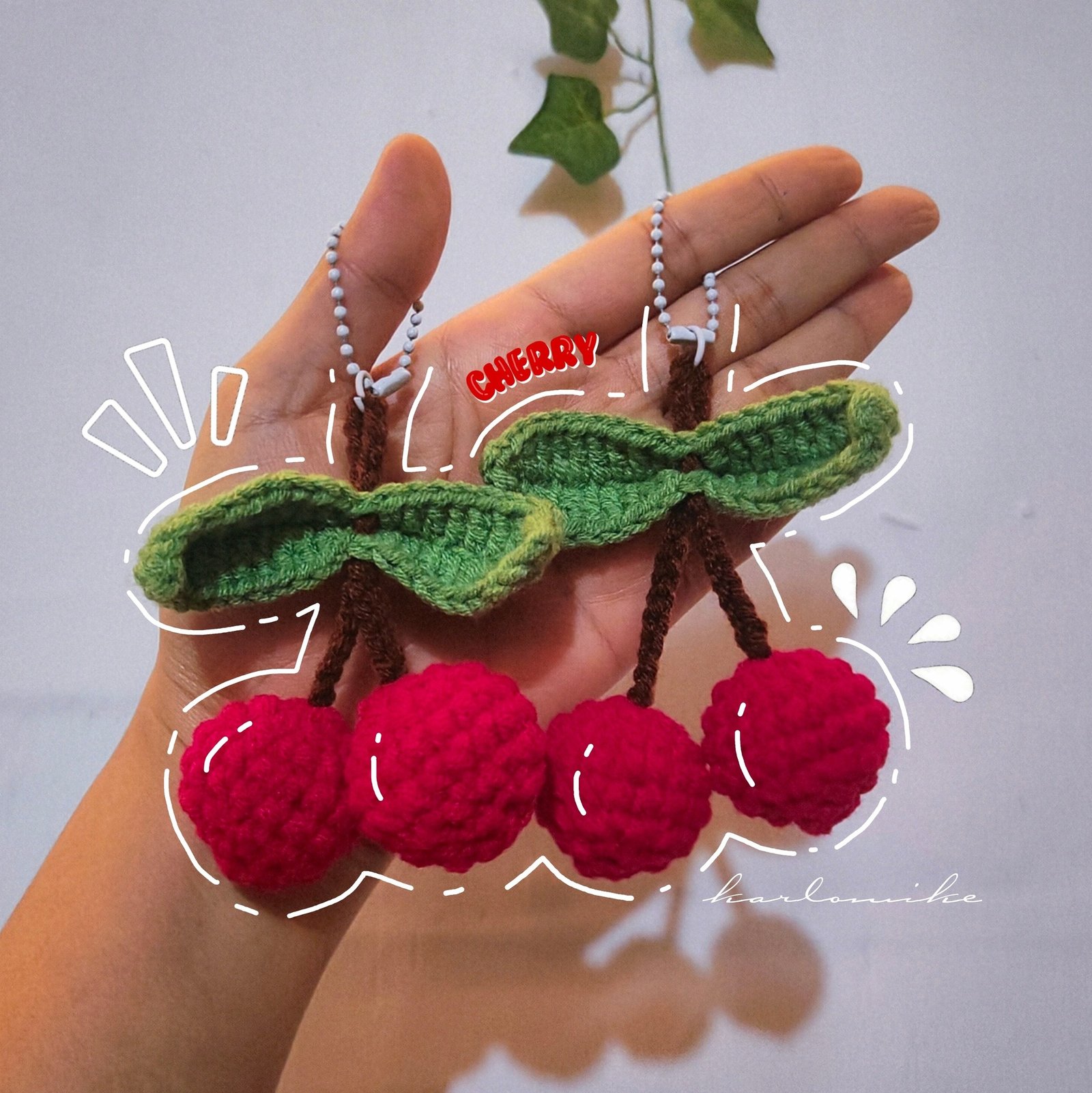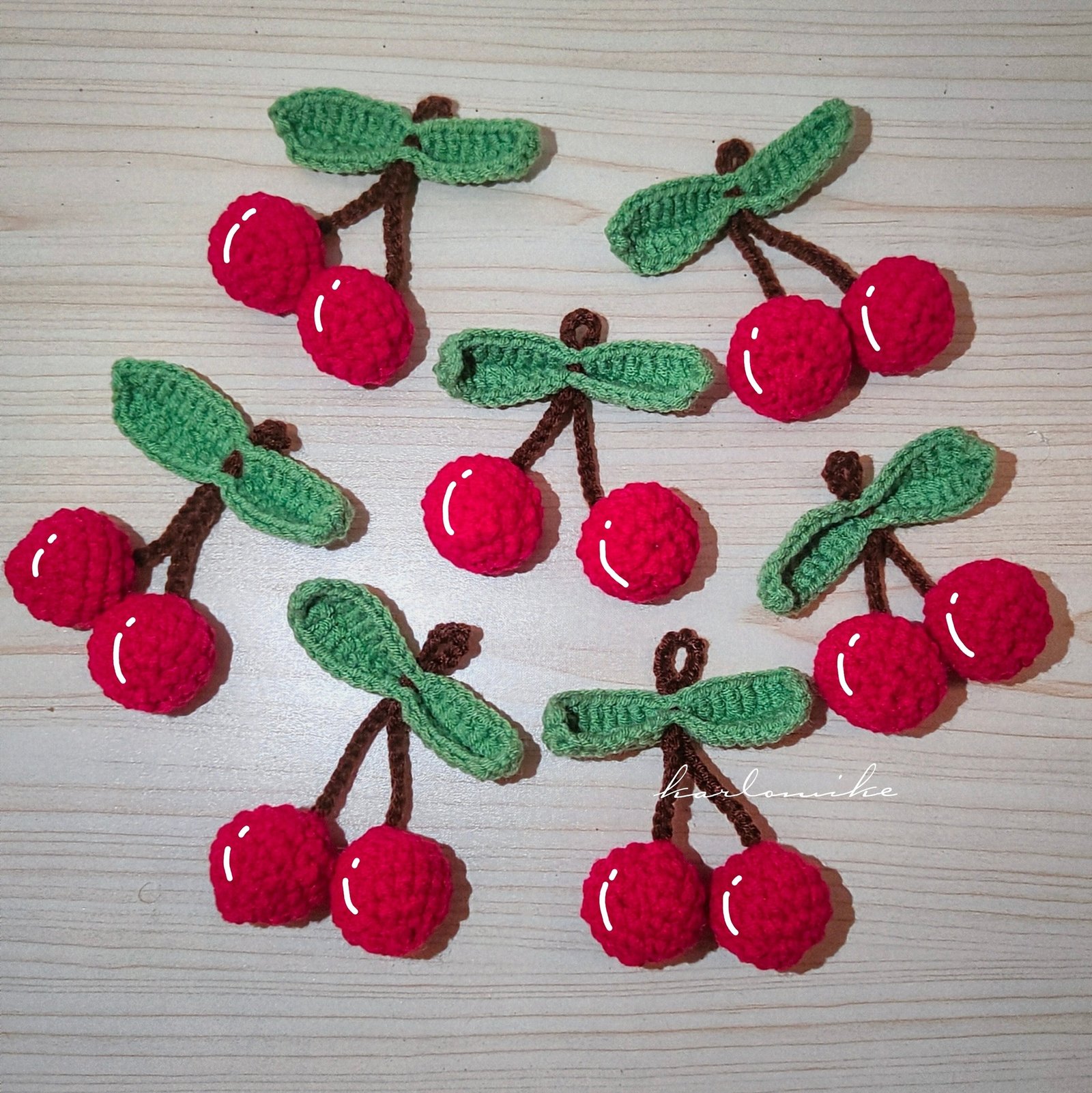If you have ever wondered how to crochet cherry crochet pattern , you are not alone. Crochet lovers around the world adore fruit-inspired projects because they are fun, colorful, and versatile. Whether you want to create a cute keychain, an applique for bags or clothing, or a beautiful decorative garland, cherries are a delightful motif. They are small enough to finish in a single sitting, yet they bring a burst of personality to any project.
Learning how to crochet cherry crochet pattern is also a fantastic way to practice shaping techniques. From creating small spheres that look like juicy fruits to adding a delicate green leaf on top, this pattern allows you to improve your skills while working on something creative. Even beginners can attempt this project with just a little patience and basic crochet stitches. More advanced crocheters will find it equally satisfying, as they can experiment with textures, yarn types, and color combinations.
In addition to being fun, cherries can be used in countless ways. Imagine making a summer headband decorated with crochet cherries, or perhaps a cozy kitchen towel with a cherry applique. These details transform simple items into unique handmade treasures. By following a crochet cherry pattern, you will not only create something beautiful but also add a touch of handmade charm to your everyday life.

Materials and Tools for Crochet Cherry Pattern
To successfully complete a crochet cherry pattern, you will need to gather the right supplies before starting. Choosing the correct yarn, hook, and accessories ensures that your cherries will look realistic and neat.
First, yarn selection is very important. A medium-weight cotton yarn is a great choice because it holds its shape well and offers a smooth finish. Cotton is also easy to wash, making your cherries durable and practical for appliques or accessories. Bright red yarn is the most traditional color, but you can experiment with pink, yellow, or even variegated yarn for a playful look.
Second, your crochet hook size should match the yarn you choose. For most cherry patterns, a 2.5 mm to 3.5 mm hook works perfectly. Using a smaller hook will make your stitches tighter, which is excellent for projects like cherries that require firmness.
Third, stuffing is optional but highly recommended if you want your cherries to have a 3D effect. A small amount of fiberfill will make each fruit look plump and realistic. Without stuffing, you can still use cherries as flat appliques for garments, bags, or blankets.
Fourth, you will need green yarn for the stem and leaf. The leaf adds a finishing touch, and the green shade creates a striking contrast with the red cherry. Choose a shade of green that complements your yarn, whether bright lime or deep forest green.
Fifth, scissors, a tapestry needle, and stitch markers are useful accessories. The scissors help cut yarn cleanly, while the needle is essential for weaving in ends and attaching parts together. Stitch markers are optional but can be helpful when working in the round.
Finally, patience and creativity are also materials you bring to the table. Crocheting cherries is simple, but taking your time to make even stitches and secure seams will make the difference between a good project and an excellent one.
Step-by-Step Guide: How to Crochet Cherry crochet pattern
Now that your materials are ready, let’s dive into the steps of making a crochet cherry pattern. This process is straightforward, even for those new to amigurumi-style crochet.
Start by crocheting the cherry itself. Most patterns begin with a magic ring, which creates a tight, closed center. From there, you crochet in rounds to build a small ball shape. Increasing stitches in the first few rounds gives the cherry its size, and decreasing stitches later helps close the sphere neatly.
After finishing the ball, you can choose to stuff it lightly with fiberfill. This gives the cherry its signature plump shape. Once stuffed, continue crocheting to close the ball, then fasten off and weave in the yarn ends securely.
Repeat the process to create a second cherry. Cherries are often seen in pairs, and having two connected fruits adds to the realistic look. You can make as many pairs as you like depending on your project.
Next, create the stem. Using green yarn, chain several stitches to form the length you desire. A short stem works well for appliques, while a longer one is perfect for keychains or decorative items. Attach the stem securely to the cherries.
Then, crochet a leaf. A small leaf pattern usually involves chaining a few stitches and working single crochets, half double crochets, and double crochets across the chain. This creates a simple leaf shape that adds elegance to the design. Sew the leaf onto the stem.
Finally, assemble everything together. Secure both cherries to the stem and make sure they hang side by side. At this point, your project is complete, and you can decide how to use your finished cherries—whether as appliques, decorations, or accessories.
Creative Ideas for Using Crochet Cherries
One of the best things about learning how to crochet cherry crochet pattern is that the finished pieces can be used in endless ways. These cherries can serve as tiny decorative accents or become the star of larger handmade projects.
A popular idea is to use crochet cherries as appliques. You can sew them onto children’s clothing, tote bags, or blankets to add a sweet and playful design. Appliques are especially fun because they can be customized in different sizes and colors.
Another creative use is jewelry. Small cherries can easily become earrings, necklaces, or even bracelets. All you need is a set of jewelry hooks and jump rings to attach the cherries. Handmade jewelry with crochet details is both trendy and unique.
Garlands are another fantastic option. By connecting multiple pairs of cherries with a long chain, you can create a cheerful garland for a nursery, kitchen, or summer party decoration. The vibrant red cherries instantly brighten up any space.
You can also make accessories like keychains, zipper pulls, or bag charms. These are quick projects that make excellent handmade gifts. Adding a crochet cherry to a simple keyring instantly transforms it into a special item.
Cherries can also be incorporated into home décor. Imagine a set of coasters with cherry appliques, or perhaps a kitchen towel with a cherry corner embellishment. Small details like these bring warmth and personality into everyday objects.
Finally, you can use crochet cherries for seasonal or holiday projects. They are perfect for summer-themed crafts, fruit baskets, or even Christmas decorations when made in glitter yarn. Their versatility makes them a staple motif for many crafters.
Tips for Perfect Crochet Cherries
Even though cherries are a simple project, a few tips can help make your crochet cherry pattern turn out beautifully. Paying attention to details will make your handmade fruit look polished and professional.
Always use tight stitches when crocheting cherries. Loose stitches may leave gaps that make stuffing visible, which reduces the neatness of the final look. A smaller hook can help if your stitches are naturally loose.
When stuffing, avoid overfilling the cherry. Too much stuffing will stretch the stitches and create bumps. Use just enough fiberfill to make the cherry plump without distorting the shape.
Choose yarn colors carefully. The charm of cherries lies in their vibrant contrast between red and green. Using rich, bright yarn makes the fruit look more realistic and appealing. Experimenting with pastel or unusual colors can also create a fun, whimsical effect.
Take your time when sewing the stem and leaf. Securely attach the parts so they don’t come loose with use. A well-stitched connection makes your project durable, especially if you plan to use it as jewelry or an accessory.
Blocking may not always be necessary for small projects, but if your leaf curls or twists, lightly blocking it will improve its shape. This step ensures your cherries look neat when attached to garments or displayed as decorations.
Finally, practice is key. The more you repeat the process of crocheting cherries, the better your stitches and shapes will become. With practice, you can even design your own variations of the crochet cherry pattern to make your work truly unique.
FAQ: How To Crochet Cherry crochet pattern

1. Is the crochet cherry pattern suitable for beginners?
Yes, cherries are a beginner-friendly project. They use basic stitches like single crochet, increases, and decreases, making them an excellent practice piece.
2. How long does it take to crochet a cherry?
Most cherries can be completed in under an hour. If you plan to make multiple cherries for a garland or applique, it may take a few hours depending on the size of your project.
3. Can I use different yarn types for crochet cherries?
Absolutely. Cotton is recommended for durability and neatness, but acrylic yarn also works well. You can even use velvet or chenille yarn for a soft, plush look.
4. Do I need stuffing for crochet cherries?
Stuffing is optional. If you want flat cherries for appliques, you can skip it. For 3D cherries, a small amount of fiberfill creates a realistic, plump shape.
5. What can I make with crochet cherries?
You can create appliques, jewelry, garlands, keychains, and home décor items. Cherries are versatile and can be adapted for many different projects.
6. How do I attach crochet cherries securely?
Use a tapestry needle and the long yarn tail to sew the cherries onto stems or other items. Make sure to weave in ends securely for durability.
In this article, we explored how to crochet cherry crochet pattern from start to finish. You learned about the materials, step-by-step instructions, creative ideas, and tips for making perfect cherries. We also answered common questions to help you succeed in your project.
Crochet cherries are small, simple, and incredibly versatile, making them a wonderful addition to your handmade crafts. Whether you use them as appliques, accessories, or decorations, they bring joy and creativity to any item.
I would love to hear your thoughts! Please share your honest opinion about this guide and leave your suggestions for future crochet topics. Your feedback helps improve and inspires new ideas for all crochet lovers.
 Skip to content
Skip to content
